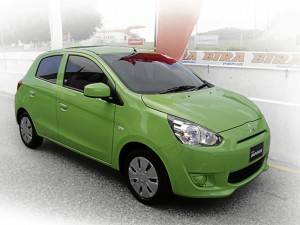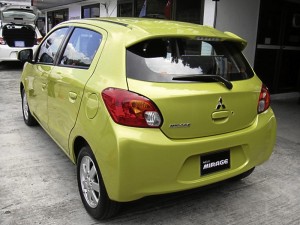If you remember the Mirage, then you must have been around in the 1970s and 1980s because Mitsubishi’s subcompact car dropped out of sight after that era—at least in the Philippines. But this year, the Mirage is making a big comeback as Mitsubishi Motors Corp.’s (MMC) new global strategic model after making its world debut at the 33rd Bangkok International Motor Show last March and being test-driven at Bira Circuit near Pattaya, Thailand, by motoring journalists from Asean countries including the Philippines earlier this month.
The 2013 Mirage will be marketed worldwide as a low-tech, low-cost, lightweight subcompact car with an all-new platform and a new 3-cylinder 1.2 liter MIVEC engine that sips less fuel than a hybrid car in Japan and spouts minimal carbon dioxide while delivering good road performance and drivability. Developed under MMC’s “Global Small Concept,” the new Mirage will be offered as an affordable entry-level small car in emerging markets while its fuel efficiency and low cost are intended to appeal to mature markets. The plan is to market it first in the Asean region and Australia, followed by Japan and Europe next year.
Eco-car. Averaging 22 kilometers per liter, the new Mirage easily meets the eco-car certification requirements in Thailand, where it began mass production last April at the Lamchabang factory of Mitsubishi Motors Thailand Co. Ltd. To be certified as an eco-car, a vehicle must achieve fuel economy of 5 liters/100 km (20 km/liter) or better under European testing methods, achieve EURO4 level emissions performance or higher and emit not more than 120 grams of carbon dioxide per kilometer. In addition, the vehicle must meet passenger safety standards for both front and side impact as specified by UNECE Reg. 94 and Reg. 95, respectively.
For MMC, the car maker that pioneered direct fuel injection technology in mainstream cars in the 1990s and employs advanced, cutting-edge technologies in its bigger products like the Lancer Evolution, Pajero and Outlander, producing a low- tech, low-cost, low-weight and low-fuel consumption small passenger car for the world market marks a totally new direction.
At a press conference in Bangkok last Wednesday, Mitsubishi corporate general manager for the Global Small Project Takashi Sato reportedly said that they have put a lot of energy into the fundamental technology of the Mirage. For example, the weight (830-870 kg) is about 10 percent lighter than the competition due to painstaking reduction in weight throughout almost every part of the car down to the smallest parts supplemented by the aerodynamic design with a drag coefficient of just 0.29. By minimizing the grille openings and placing the front bumper undersurface, airflow around the front end was maximized.
Simple. The Mirage’s all-new platform provides a tough body while making it one of the lightest cars in its segment, if not the lightest. The mandate was to keep things simple, affordable and efficient. Sato said that the Mirage’s simplified platform has no provision for all-wheel-drive, a 4-cylinder engine or diesel and the steering wheel has no reach adjustment. He pointed out that it isn’t necessary to use expensive direct-injection systems on the Mirage as proven by the engine’s carbon dioxide emission level matching that of the direct-injection-equipped Nissan Micra sold in Europe.
(By the way, aside from 10 Mirage units, a Nissan Micra and Honda Brio were also on hand at Bira for comparison test driving.)
Sato claimed that in Japan’s market, the Mirage’s fuel consumption level is better than hybrids, without any expensive, sophisticated technologies. The new 1.2-liter, 3-cylinder MIVEC engine produces 78 PS at 6000 rpm and max torque of 100 Nm at 4000 rpm. Adequate power for city driving, which is what the Mirage was really designed for.
The only costly technology that MMC chose to include in the Mirage was the INVECS-III CVT [Continuously Variable Transmission] because it was required to reduce fuel consumption. But the CVT has no preset gear ratios for pseudo-manual driving. A 5-speed manual transmission Mirage with a light clutch and smooth gearshift is also available, offering more linear torque delivery and better acceleration than the CVT.
Minimalist. The new Mirage has a minimalist, conservative exterior, no way as stylish as the new Kia Rio or the Ford Fiesta. MacPherson struts in front and torsion beams in the rear make up the suspension while electric power steering facilitates tight space maneuvering and parking. Ventilated disc brakes at the front and leading/trailing drums at the rear provide stopping power together with ABS and EBD. The 165/65R tires have full wheel covers in the GLX while the GLS and GLS Limited have lightweight aluminum wheels.
A driver’s side airbag comes standard in the GL and GLX units while the GLS and GLS Limited have two airbags. Conveniences range from keyless operation to a keyless entry system, DVD player with 7-inch touch-screen monitor, Bluetooth and Navigation system, USB connector, radio-CD with MP3 player and front AUX-in, depending on the vehicle’s trim level. Black is the keynote trim color in the cabin, whatever the body color and the cloth trim front seats are supportive although needing more side bolstering. The low beltline and slim A pillars allow for good forward and side visibility. The interior offers surprisingly generous head and legroom for all passengers.
The good news is that the basic, no-frills MT Mirage may be sold in the PH for less than P550,000. If this pricing pushes through, competitors like the Kia Picanto, Chevy Spark, Hyundai i10 and Suzuki Celerio and Alto have reason to worry. In Thailand, the no-frills Mirage GL MT sells for 380,000 baht (around US$12,260 or P533,310). Just weeks after the Mirage was launched there, more than 23,000 units of various trim levels had been ordered, exceeding the monthly sales target of 2,000 units and requiring the Lamchabang plant to ramp up production. That augurs well for Mitsubishi’s new global eco-car, the Mirage.



